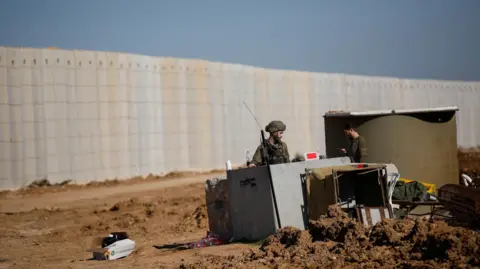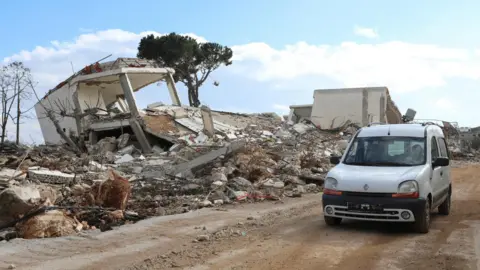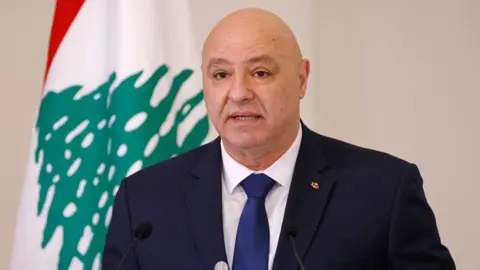15 Israeli forces were reported killed after the withdrawal date.
BBC News, Beirut
 Reuters
ReutersThe Lebanese Health Ministry says Israeli soldiers killed 15 people and wounded more than 80 in southern Lebanon, as the Israeli army remained in parts of the country after a deadline to withdraw them, removing Hezbollah from the area, passed.
On Sunday morning, thousands of residents returned to towns and villages along the border, despite warnings by the Lebanese and Israeli armies, and the United Nations, that the area remained unsafe.
Israel said the 60-day ceasefire agreement with Hezbollah had not been fully implemented, and it remained unclear how many of its soldiers were in Lebanon or how long they would remain.
According to the Lebanese Ministry of Health, Israeli forces attacked people as they tried to enter locations still under occupation. The Lebanese army said that one of its soldiers was killed and another wounded by Israeli fire.
The Israeli military said it fired “warning shots in multiple areas” of southern Lebanon, without specifying whether people were beaten, and arrested several people who claimed it represented an “imminent threat.”
The ceasefire deal, brokered by the United States and France that brought an end to the 14-month conflict, provided for the withdrawal of Israeli forces and the removal of Hezbollah fighters and weapons from southern Lebanon. At the same time, thousands of Lebanese soldiers were expected to be deployed to the region where Hezbollah was, for decades, the dominant force.
A Western diplomatic official familiar with the negotiations, who spoke on condition of anonymity, said Israel said it needed more time to destroy Hezbollah infrastructure in southern Lebanon, and that the initial plan was for a 30-day extension.
In recent days, Hezbollah’s Al Manar television station appeared to be encouraging people to return south, and in some places, convoys arrived waving the group’s yellow and green flag.
Passing the ceasefire deadline is the first major test for Lebanon’s new president, army chief Joseph Aoun, who is keen to bring stability to a country exhausted by multiple crises.
In a statement issued on Sunday, he said that “Lebanon’s sovereignty and territorial integrity are non-negotiable,” adding that he is “following this issue at the highest levels.”
The conflict escalated last September, leading to an intense Israeli air campaign across Lebanon, the assassination of Hezbollah leaders and a territorial invasion of southern Lebanon. The attack killed about 4,000 people in Lebanon – including many civilians – and displaced more than 1.2 million people.
On Friday, the Israeli Prime Minister’s Office said that the withdrawal outlined in the ceasefire was “conditional on the Lebanese Army deploying in southern Lebanon and fully and effectively enforcing the agreement, while Hezbollah withdraws beyond the Litiani,” a river about 30 kilometers away (20 (20) Miles) of the unofficial border between Lebanon and Israel known as the Blue Line.
“Since the ceasefire agreement has not been fully implemented by the Lebanese state, the gradual withdrawal process will continue, in full coordination with the United States,” the statement said.
In a statement on Saturday, the Lebanese army said it continued to “implement the plan to enhance deployment” in areas along the border, but there was “a delay at some stages due to the Israeli enemy’s procrastination in withdrawing, which complicates the army’s deployment mission.”
There was no immediate reaction from Hezbollah. On Thursday, the group said failure to comply with the deadline would be a “flagrant violation of the agreement, a violation of Lebanese sovereignty, and the entry into a new phase of the occupation.”
 Reuters
ReutersHowever, the statement did not say how the group would respond if Israeli forces remained in the country.
Perhaps this is an indication of the delicate situation the group finds itself in. The Iranian-backed political and social movement has been weakened, and severely weakened in the conflict with Israel, although it continues to enjoy significant support among Shiite Muslims in Lebanon.
The ceasefire deal was widely viewed as a surrender by the group, after seeing its infrastructure and weapons arsenal depleted and hundreds of fighters and key figures killed, including long-time leader Hassan Nasrallah.
Despite some violations before the withdrawal deadline, the truce put an end to violence that had caused billions of dollars in destruction and damage, Allowing thousands of residents to return to their homes in Lebanon.
If it decides to resume its attacks, Hezbollah will face opposition from critics, who have accused the group of dragging Lebanon into a war that was not in the country’s interest, and perhaps even from some of its supporters.
 Getty Images
Getty ImagesHezbollah’s political influence has also declined.
Earlier this month, Lebanon’s parliament was able to The president was elected after more than two years of political impasse Blame by critics on the group.
AUON promised ambitious reforms to rebuild state institutions long plagued by corruption, revive the collapsed economy after years of crisis, and the right to monopolize the possession of weapons, which means an attempt to curb Hezbollah’s military power.
It remains unclear whether the military is able – and willing – to do so, amid concerns that any action against the group could spark internal violence.
Israel’s stated goal in its war against Hezbollah was to allow the return of some 60,000 residents displaced from communities in the north of the country due to the group’s attacks, and to remove them from areas along the border.
Hezbollah launched its campaign the day after Hamas attacks on southern Israel on October 7, 2023, saying it was acting in solidarity with Palestinians in Gaza.




